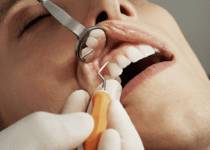Dental fistula – Guide, Solutions, Mechanisms
Dental fistula
The location of dental fistulas means that they concern several medical specialties, but it is the dental surgeon who is best placed to assess their nature. For a long time asymptomatic and often hidden in the folds of the mucous membranes, dental fistulas are nevertheless quite frequent: the errors of diagnosis and of treatment with regard to them generally go well.

what is a dental fistula
From the Latin fistula , which means “tube”, the dental fistula is a conduit connecting a lesion near the tooth with an outlet opening . This evacuation orifice opens either at the level of the gingival mucosa, or in a natural cavity of the face (sinuses, orbits, floor of the nasal cavities), or at the level of the skin. These conduits provide permanent or episodic passage to saliva or more frequently pus linked to a more or less deep dental lesion.
Some fistulas are present from birth, but most appear at various times in life. The researchers noted that it was more prevalent in young populations , aged 10 to 30 years on average.
It is the relatively discreet testimony of a “blocked” infection in the chronic stage . It can therefore take months or even years for the infection related to the fistula to be diagnosed and finally cured .
Symptoms of a fistula
Dental fistulas are not easy to spot : GPs themselves often miss it. This can be explained by the lack of clinical signs that accompany them. Most people are unaware that they have a dental problem and have equated fistula with a simple “pimple.”
However, it should be noted that on average, one in six teeth with an inflammatory status (decay, for example) causes a fistula. The teeth most affected by the phenomenon are those which are necrotic and those which have already been treated “endodotontically”, ie whose interior has been treated by a dental surgeon.
Mucous fistulas are much larger than those that pierce the skin . About 1 in 20 dental fistulas are cutaneous. However, in the event of cervico-facial fistula, it is the dental origin that must be suspected.
In general, the fistulas found on the nose, the upper lip and the infraorbital region concern the incisors and canines, while the fistulas of the submaxillary regions, the neck, the cheek concern more the molars and premolars.
The appearance will differ depending on the age of the fistula.
If it is recent, the edges are detached, even slightly edematous. If it is old, the orifice is at the bottom of a clear depression.
Most often, the opening of the fistula is slightly brownish with a light crust that falls regularly to give passage to a tiny drop of pus. The nodule is between 2 mm and 1 cm in diameter . Sometimes it is difficult to see because it is hidden in a mucous fold.
The x-ray examination is used to successfully diagnose fistula and learn about fistula paths of dental origin.
Mechanisms of fistulization
At the origin of a fistula, we often find odontological infections caused by bacteria belonging to the oral flora. When they reach deep tissues, they are likely to precipitate the onset of the most frequent dental conditions, namely cavities, gingivitis and periodontitis.
In the case of fistula, the necrosis of the dental pulp following a very advanced caries or a dental trauma gone unnoticed, is the most frequent cause.
When the pulp is invaded by bacteria, inflammation and edema quickly lead to congestion and then necrosis due to the closed and rigid space in which the tissues are held. This necrosis leads to an infection which can take two paths:
1) Either it evolves in one piece in an acute mode, causing particularly fierce pain.
2) Either it cools down quickly and becomes “chronic”: it goes unnoticed for months, even years, but can “heat up” at any time and bring back to the previous case .
This deep tissue infection, which has become chronic, can cause fistulization.
What does the “chronicity” of an infection depend on?
The chronic or acute progression depends on many factors such as the virulence of the bacteria, their number, the immune resistance of the victim, the anatomy of the affected areas and the possible discharge of pus. Since all of this can vary over time, the infection can change from chronic to acute at any time.
The place of infection, the position of the teeth concerned and those of the muscle insertions will determine whether the fistula path will pierce the skin or the mucous membrane.
Causes
The tooth decay is undoubtedly the major cause of dental fistula. Typically, fistulas are asymptomatic, but when the fistula channel comes to be obstructed, pain can appear . The affected tooth is often more or less mobile, a sign of the absence of pulpal vitality.
Bruises, subluxations, cracks and fractures can also be the cause of fistulas, due to the lesions of the pulp that they cause. The frequency of occurrence of fistula for fractured teeth was approximately 35% .
Odontological therapeutic accidents and the consequences of tooth extraction are also possible causes of a dental fistula.
Finally, impacted teeth, those teeth which have not completely erupted in the oral cavity (this is often the case with wisdom teeth), can cause pericoronitis and various infections of the gums, the chronicity of which can occur. accompany by drainage to the oral cavity.
Supported
To eradicate dental fistula, it is essential to treat the dental cause at the origin of the skin or mucous membrane lesion. Antiseptic or antibiotic attempts will have no effect until the cause is treated. Once resolved, the fistula tends to go away quickly , between 5 and 15 days, although a slight scar may persist, especially if the fistula is old. After a few months, it nevertheless goes unnoticed


